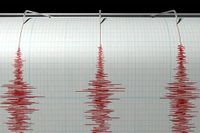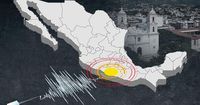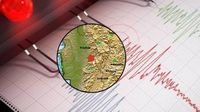On April 5, 2025, a series of seismic events unfolded across South America, with notable activity reported in Chile, Peru, Colombia, and Mexico. These tremors, varying in magnitude and depth, highlight the region's position along the Pacific Ring of Fire, known for its geological volatility.
In Chile, the day began with significant seismic activity. At 09:07 local time, a sismo with a magnitude of 3.4 was recorded 19 km east of Pica, at a depth of 99 km. This was followed shortly by a more intense tremor at 08:22, with a magnitude of 4.6, located 12 km northwest of Navidad, and a depth of 36 km. Additionally, two smaller quakes were reported near San Antonio de los Cobres, both registering magnitudes of 3.3 but occurring at depths of 224 km and 229 km respectively. The day also saw a 3.9 magnitude sismo 98 km northeast of Cabo Raper at a depth of 27 km. The Chilean authorities, through the Centro Sismológico Nacional (CSN), continue to monitor these events closely.
Chile's seismic history is marked by significant earthquakes, including the most powerful recorded in history, which occurred on May 22, 1960, in Valdivia, reaching a magnitude of 9.5. This catastrophic event resulted in widespread destruction and loss of life, and it serves as a stark reminder of the potential risks associated with living in a seismically active region.
Meanwhile, in Peru, seismic activity was also notable on the same day. A sismo of magnitude 3.6 struck at 06:39 local time, located 8 km east of Calacoa, Mariscal Nieto, with a shallow depth of just 8 km. Earlier, at 04:40, another tremor of 3.7 magnitude was recorded 16 km east of Cusco, also with an intensity of III. The Instituto Geofísico del Perú (IGP) reported these tremors, emphasizing that the region's seismicity is largely due to the convergence of the Nazca and South American tectonic plates.
Hernando Tavera, the president of the IGP, explained, "In Peru, all seismic activity results from the collision of the Nazca plate with the South American plate, which is essentially a head-on collision between two plates." He also noted that predicting earthquakes remains an elusive goal, stating, "Predicting means knowing where it will occur, the magnitude, and the exact time; however, we have made advancements in forecasting, which allows us to identify probable locations and potential magnitudes."
In Colombia, a 3.4 magnitude tremor was reported in the department of Chocó at 14:27 local time, with a depth of 84 km. The Servicio Geológico Colombiano (SGC) confirmed the event, noting that it was felt in various cities, including Medellín, but no damages were reported. The SGC highlighted that Colombia’s geographical location at the convergence of multiple tectonic plates makes it susceptible to seismic activity.
Across the border in Mexico, a sismo of magnitude 4.4 occurred at 00:09 AM on April 5, 2025, approximately 93 km south of Cd Hidalgo, Chiapas, at a depth of 5.8 km. This was part of a broader pattern of seismic activity in the country, which is situated in a highly active geological zone. The Centro Nacional de Prevención de Desastres (Cenapred) urged the public to remain calm and to stay informed through official channels in the wake of these events.
Historically, Mexico has faced devastating earthquakes, including the catastrophic quake of March 28, 1787, which registered a magnitude of 8.6 and caused significant destruction and a tsunami that reached 6 kilometers inland. More recent notable events include the 1985 and 2017 earthquakes, which resulted in substantial loss of life and property.
As the region braces for continued seismic activity, experts recommend preparedness measures for residents. These include having an emergency backpack ready, knowing evacuation routes, and participating in earthquake drills. The importance of remaining calm and following safety protocols during a seismic event cannot be overstated, as these practices can significantly reduce the risk of injury.
In summary, the seismic events of April 5, 2025, serve as a reminder of the geological forces at play in South America. With ongoing monitoring and preparedness, authorities aim to mitigate the risks associated with living in such an active seismic zone. As the Pacific Ring of Fire continues to release energy, communities must remain vigilant and informed to ensure safety and resilience against future tremors.










